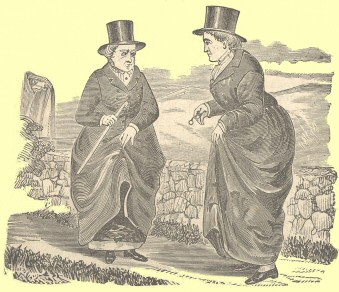Transcribed from the H. Jones edition , email
AN ACCOUNT
OF THE
LADIES OF LLANGOLLEN.
BY THE LATE REV. J.PRICHARD, D.D.
PRICE TWO PENCE
Printed andPublished by H. Jones, at the Atmospheric Gas Printing
Works, “Advertiser” Office,Llangollen.
p. 2LADYELEANOR CHARLOTTE BUTLER AND MISS SARAH PONSONBY,
OF PLAS NEWYDD.
Lady Eleanor Butler and MissPonsonby were Irish ladies of rank and beauty, who loved eachother with an affection so true that they could never bear theidea of the separation which the marriage of either wouldnecessitate. They, therefore, resolved on lives ofcelibacy, and, refusing many handsome offers, fled fromhome. They were, however, overtaken and brought back totheir respective relations. Many attempts were made to drawMiss Butler into marriage, but all were in vain. In a shorttime the ladies eloped again, each having a small sum with her;and it was said that, although Lady Eleanor arrived here in thenatural aspect of a maid of 34, Miss Ponsonby accompanied her inthe guise of a smart footman, in top boots and buskinbreeches. It was about the year 1778 when these errantladies visited Llangollen. While rambling along thischarming locality, their eyes rested on a gentle eminence nearthe village, and there they resolved to fix their abode. They, accordingly, purchased the estate, built a new cottage onthe site of the old one, laid out gardens, pleasure grounds,rural walks and bridges, by which they might enjoy the naturalcharms of this picturesque retreat. Their mode of lifebeing very singular, and their costume still more so, they soonbecame noticed by the many travellers who passed through NorthWales. The celebrated comedian Charles Mathews thusdescribes their appearance:—p. 3“As they are seated, there isnot one point to distinguish them from men; the dresses andpowdering of the hair, their well-starched neckcloths, the upperpart of their habits (which they always wear, even at a dinnerparty) made precisely like men’s coats, with regular blackbeaver hats, everything contributing to this semblance. Tocrown all, they had crop heads, which were rough, bushy, andwhite as snow.”
Plas Newydd was built at the north-east end of a field calledthe Maes, and was, therefore, calledPenymaes—The end of the Maes.
The ladies were, according to their means, charitable to theaged, sick, and infirm; and had been taught, by wisdom andexperience, that the best way to help the poor labourer was bygiving him employment. The workman, having preciouscommodities for the market of the world—physical power,knowledge, and good common sense—that were of more value tosociety than gold or la

